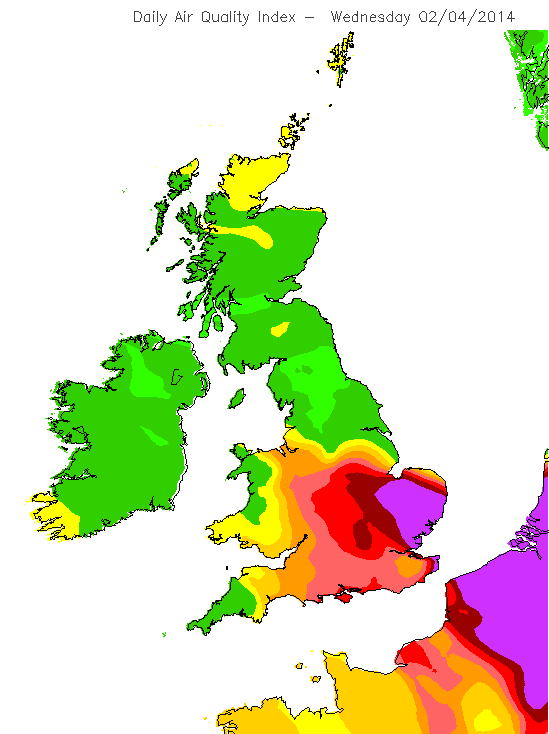Air Pollution: Five Things You Need to Know About the Saharan Dust Blowing Across UK

Warnings have been issued over very high levels of air pollution across the UK following dust being blown in from the Sahara desert.
Adults and children with lung problems have been advised to stay indoors, while all people have been advised to reduce physical activity if they experience a cough or sore throat.
Experts at the Department for Environment & Rural Affairs said the pollution levels will remain elevated over the coming days.
IBTimes UK has looked at the top 10 things you need to know about the air pollution across the UK.

Where and when?
Defra said the worst affected areas, which will have "very high" air pollution, include parts of East Anglia and the East Midlands. "Moderate to High air pollution levels are forecast for central and southeast England, to the south and east of a line from around The Wash to Cheshire to east Devon," it said.
The elevated pollution levels are expected to continue throughout today and tomorrow. On Friday they should return to low levels in most parts of the country, except "southwest England, Kent, North Yorkshire and parts of southern Scotland due to ozone".
The levels are currently on around five or six on Defra's 10-point scale but are expected to get higher tomorrow (Thursday). Andrew Sibley, specialist forecaster for the Met Office, told the BBC: "Conditions are going to get worse again as we go through Wednesday and the rest of the week."
Why?
The high pollution levels are the result of an unusual combination of factors, including a mix of local and European emissions, coupled with the dust blowing in from the Sahara. Light winds have also exacerbated all these factors.
A Defra spokeswoman said: "The high level of air pollution this week is due to a combination of local emissions, light winds, pollution from the continent and dust blown over from the Sahara."
Speaking to Sky News, weather presenter Nazaneen Ghaffar said there are strong dust storms moving across the Sahara at the moment, and the winds in the upper atmosphere are sending the particles our way.
"The reason we've seen the orange deposits is because of recent rainfall. Any rain clears the dust from the upper atmosphere, bringing it down to lower levels, and as the water evaporates it leaves behind the orange dust."
Is it dangerous?
There are dust and sand particles in the air, as well as pollutants including monoxide, nitrogen dioxide that can be inhaled causing health problems. It can cause runny eyes and noses, coughs, sore throats among the general population. However, people with pre-existing conditions such as heart and lung problems are at a far higher risk.
Defra has advised people at risk to stay indoors. People with lung problems have also been advised to make sure they have access to their inhalers. However, experts have said wearing a face mask is not necessary. Carol Cooper, a London GP, told Sky News: "A good piece of advice is not to bother. They're not generally very effective and wearing one can actually make breathing more difficult."
Is travel affected?
Flights were grounded at Heathrow yesterday because of a thick blanket of fog surrounding the airport. Around 95 flights were cancelled. A spokeswoman said: "Due to low visibility caused by heavy fog, the airport is currently experiencing delays to its service." Several other airports experienced problems because of the fog, including Cardiff, where many flights were delayed or diverted.
A spokesman for the British air traffic control service, Nats, said it was not aware of any disruption to flights as a result of air pollution.
How does Defra work out the air quality?
Defra's air quality forecast looks at five pollutants – ozone, nitrogen dioxide, sulphur dioxide, PM2.5 and PM10 particles. All of these can impact on your health.
"The Met Office model uses UK and European maps of annual average pollutant emissions to simulate the release of chemical species into the atmosphere," Defra explained. "These are then allowed to chemically react according to prescribed reaction rates which depend on factors including the concentration of the species, the temperature and the amount of sunlight.
"Species are then transported and dispersed within the model according to the winds and the concentrations are re-evaluated. Using the concentrations calculated in this way throughout the forecast period, the Daily Air Quality Index is calculated as an average over prescribed time periods."
© Copyright IBTimes 2025. All rights reserved.






















